-
Engine5.7L Eight-Cylinder
-
Power381 HP / 401 LB-FT
-
Transmission6-Speed Auto
-
0-60 Time6.5 Seconds (MT)
-
DrivetrainFour-Wheel Drive
-
Curb Weight5,765 Pounds
-
Towing8,200 Pounds
-
Seating8 Passenger
-
MPG13 City / 18 Highway
Surefooted Workaholic Tamed For Civilian Duty
An ox is a domesticated bovine whose primary purpose is to pull heavy loads. Tipping the scales at more than a ton, the hefty animals are not considered quick workers, especially when compared to horses, but they're steadfast in their actions and respond well to trained commands. Rarely spooked or unsettled, oxen deliver a long, dependable and rather unassuming service life.
Toyota's Land Cruiser is the ox's four-wheeled equivalent. While the full-size sport utility vehicle is one of the automaker's slowest-selling vehicles on U.S. shores – and one of its most expensive – those who've owned one tend to become very loyal fans. We recently spent a week with the current "200 Series," the latest generation of the venerable 'ute that has been in production since the 1950s. What has given the Land Cruiser such longevity and how does it compare to the Lexus LX570, its nearly identical twin? Most importantly, did we become loyal Land Cruiser devotees in the process?
The Land Cruiser is as legendary as John Wayne. The off-roader traces its roots back to 1951, when Toyota Motor Corporation built itself a rival to the rugged, war-proven U.S. Jeep and British Land Rover. The Japanese automaker called its vehicle the "Jeep BJ." After proving itself by driving up to the sixth-stage of Mount Fuji – no other vehicle had ever accomplished the task – the country's National Police Agency ordered 289 copies. In 1954, Hanji Umehara came up with the famed "Land Cruiser" name.
Early BJ and FJ models were followed by numerous generations of Land Cruisers, which each bore a numerical series name (Model 20, 30 Series, 40 Series, 55 Series, 60 Series, 70 Series, 80 Series, 90 Series, 100 Series and 120 Series, which ended production in 2007). In 2008, Toyota introduced the all-new 200 Series, based on a heavily modified Toyota Tundra chassis. While other countries are offered a bevy of engine options, including turbodiesel configurations, the eight-passenger truck is loaded with features and positioned as a flagship in the U.S. where it's sold as the Land Cruiser and also re-badged as the Lexus LX570.
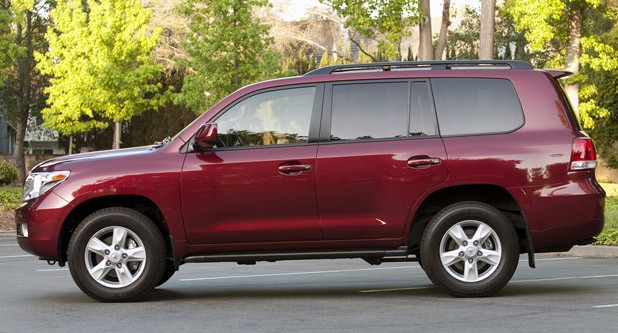
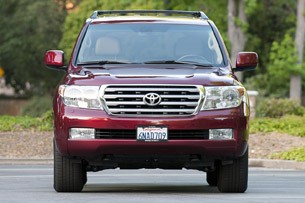
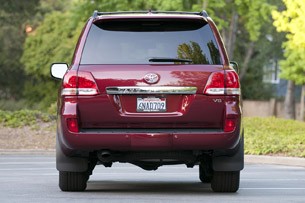
The current Series 200 debuted to intense scrutiny from loyalists, which was expected. While Toyota fitted it with a more substantial brake system and addressed front suspension issues that had plagued its predecessors, many felt the styling was far too conservative. Nevertheless, the vehicle was as rugged as ever, easily capable of leading the competitive Land Rover Range Rover through the harshest of off-road environments. It's that same durability that continues to make the Land Cruiser the vehicle of choice for NATO and armed forces around the globe. Not to mention the baddies they're battling.
At the heart of the Land Cruiser is a burly 5.7-liter V8 (3UR-FE), which is also shared with the Toyota Tundra, Toyota Sequoia and Lexus LX570. With an all-aluminum construction, the 32-valve powerplant develops 381 horsepower at 5,600 rpm and 401 pound-feet of torque at 3,600 rpm. The standard transmission is a six-speed electronically-controlled automatic transmission sending power to a full-time four-wheel-drive system.
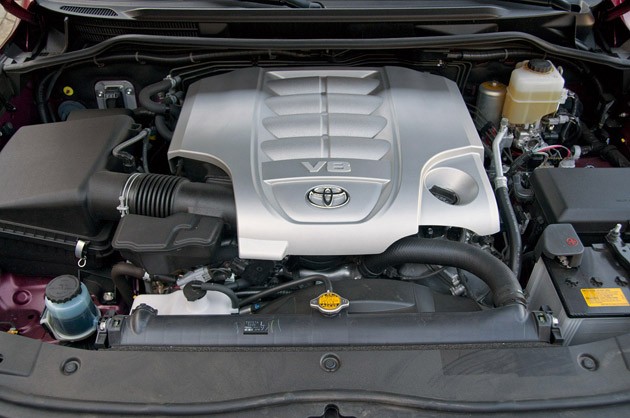
Its mechanicals include a two-speed transfer case with a Torsen limited-slip locking center differential that delivers 60 percent of the power to the rear wheels under normal driving conditions. Modern digital aids include traction control (TRAC), Hill-start Assist Control (HAC) and Vehicle Stability Control (VSC). There's also a multi-speed electronic "Crawl Control" to automatically manage throttle and brake action at crawling speeds during serious off-road excusrions. If the driver wishes, everything but the steering may be managed by the Land Cruiser when traveling off the beaten path.
The front suspension is a coil spring double-wishbone configuration, with the rear a four-link trailing-arm solid-axle. While the Lexus LX570 boasts Active Height Control (AHC) and Adaptive Variable Suspension (AVS), the slightly less expensive Land Cruiser makes due with standard coil springs. And, where the Lexus wears flashy 20-inch alloys (285/50R20), the Toyota is fitted with standard 18-inch units (285/60R18) with taller sidewalls for improved off-road ride and performance. The brakes on the Land Cruiser are identical to those on the LX570, with both featuring four-piston calipers up front (13.4-inch rotors) and dual-piston calipers in the rear (13.6-inch rotors). Toyota says the anti-lock braking system has been calibrated for use both on- and off-road.
The capabilities of a mechanical ox don't come lightly or cheaply. Toyota lists the curb weight of its Land Cruiser as 5,765 pounds (more than two hundred pounds lighter than the Lexus LX570). Our test model carried a base price of $65,970 (plus $810 for deliver and processing), but was fitted with the Upgrade Package (DVD navigation, backup camera, rear seat entertainment, etc...) bringing the total to $74,210. For comparison, the Infiniti QX56 4WD starts at $61,800 and the Land Rover Range Rover starts at $79,685.
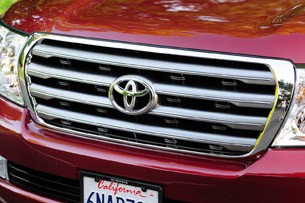
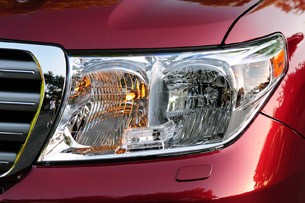
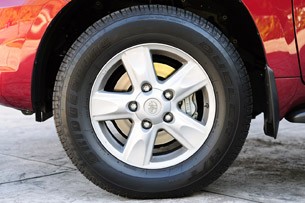
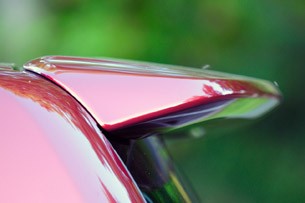
Surprisingly smaller in overall stature than the Toyota Sequoia, the Land Cruiser is a legitimate eight-passenger vehicle that seats five comfortably. There are two bucket seats up front with a conventional three position bench in the second row. The three additional seating positions are stowed, like jump seats in a military C-130 transport aircraft, folded against the side walls of the rear cargo area until the troops need them (yes, they waste precious cargo space in the process). A swift pull drops them into the place. Once secured, don't set hopes too high as the accommodations in the third row are decidedly third class. Legroom is tight and the seating position won't even keep children happy for long. If that doesn't dissuade you, the crawl into the way-back through the second-row tumbled seat will.
Other than the three passengers banished to the back, the five other occupants in the Land Cruiser's cabin will be very happy. Four-zone climate control is standard, with 28 (!) vents ensuring that gentle breezes blow throughout the passenger cabin. For extreme cold, when a traditional coolant-based heater may not be up to the task, the Toyota is also equipped with a standard electrically-heated ceramic element to keep passengers cozy. Other standard features include privacy glass, smart key, heated front seats, auto-dimming mirrors and a 14-speaker JBL premium sound system with in-dash six-disc CD changer. The very short options list includes a rear seat entertainment system, simulated wood/leather steering wheel, cool box, rain-sensing wipers, rear spoiler and second-row seat heaters.
The cabin fit and finish is good, but the materials seem chosen for their durability over luxury. Most of the surfaces seem hard and plastic. Even the fake wood, which Toyota makes no attempt to hide by calling it "wood-grain-style trim," is embarrassingly cheap in appearance and feel. On the plus side, one gets the impression that a wet towel will wipe the dirt and dust off everything without any damage. While nearly identical mechanically, the LX570 and Land Cruiser each have a unique dashboard and center console. We prefer the look of the Toyota, sans the bluish-tint common on late-model Lexus products.
While oxen have a very difficult time balancing on three legs (they are often hung in slings when shoeing), Land Cruisers are as surefooted as mountain goats both on- and off-road. All Land Cruisers sold in our market are fitted with Toyota's Kinetic Dynamic Suspension System (KDSS) as standard equipment. In layman's terms, it means the front and rear sway bars are acted upon by hydraulic cylinders. By varying the pressure exerted on each bar, and through pressure-sensing valves, sway stiffness may be altered while driving. At one end of the scale the system sets itself to firm to significantly reduce the SUV's body roll during on-road cornering. At the other end, the system will disengage itself from the sway bars allowing each wheel to deliver impressively generous travel while off-road. It is innovative engineering that seems to work very well.
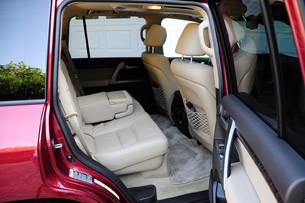
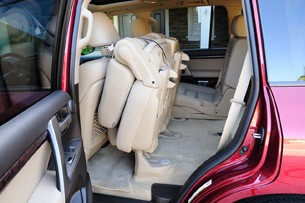
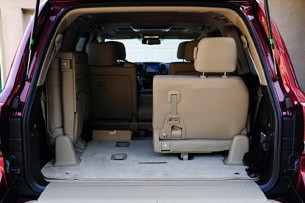
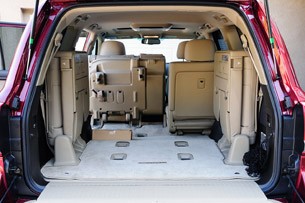
The weekend the Land Cruiser was in our garage was also the same weekend we were racing a spec-class Porsche Boxster with the Porsche Owner's Club at Willow Springs. With the Land Cruiser conveniently fitted with a standard Class III tow hitch, we decided to put it to work. Hooking the trailer to the Land Cruiser was simple, thanks to the back-up camera that makes easy work of maneuvering. When the trailer wheel is lifted and the truck bears the tongue weight, the rear of the Land Cruiser drops a couple inches. That wasn't an issue until later, when we noticed our fixed headlights blinding oncoming traffic at night. It was the only time we wished for the LX570's self-leveling air suspension.
The Boxster/trailer package came in at about 5,500 pounds – safely below the Toyota's 8,200-pound towing limit – and the SUV barely broke a sweat. Fourth gear in the six-speed gearbox is a direct drive, while both fifth and sixth gears are overdrive ratios. An electronic control unit estimates road conditions to select the proper gear and in practice does an excellent job, with very little hunting even while towing. In addition, the engine also features a water-cooled oil cooler to help control temperatures while under extreme loads. The Land Cruiser made an excellent tow vehicle with a near-perfect combination of power, stability and passenger comfort (we also really liked the "Cool Box" for keeping our drinks cold).
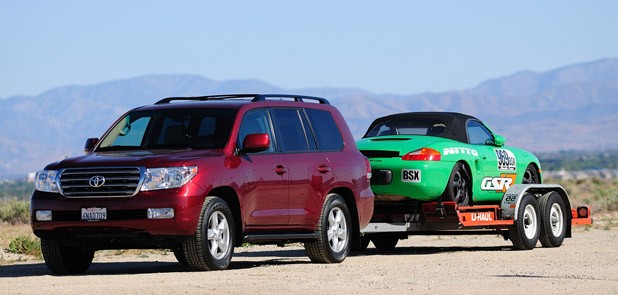
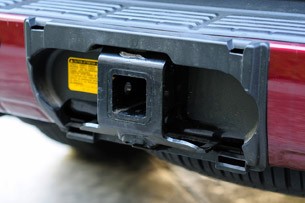
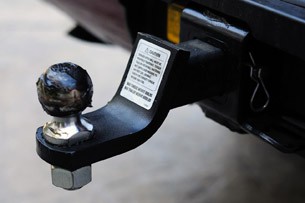
Unfortunately, while the Land Cruiser reminds us of an ox with regards to its temperament and work ethic, it drinks like a dehydrated camel. The EPA rates the vehicle at 13 mpg city and 18 mpg highway, but our real-world experience says to expect much less if you don't spend a lot of time on the highway. The only upside is that its large 24.6 gallon fuel tank promises a semi-decent range between costly fill-ups.
Nitpicking, our sole gripe with the Land Cruiser has nothing to do with those terrible third-row seats or its thirst for fuel – those are compromises we can live with. Our frustration is found with the simple 80's-era halogen headlamps. Toyota touts the commonplace bulbs as "field serviceable" and cites concern with glare from modern HID systems. We say we've seen brighter LED battery-powered flashlights.
Other than the illumination issue, we found the big Toyota enjoyable and easy to live with. Acceleration is impressive (Motor Trend recorded a 0-60 time of just 6.5 seconds) and the brakes are more than up to the task. The driving position is comfortable and commanding with outward visibility that never bothered us whether navigating city streets, changing lanes on the highway or while parking (the reverse camera helps). Kids found it easy to get both in and out, and they commented on the big door handles, expansive windows, overhead air conditioning vents and generous storage within the cabin. The Land Cruiser is expensive, but we don't think any owners will feel buyer's remorse.
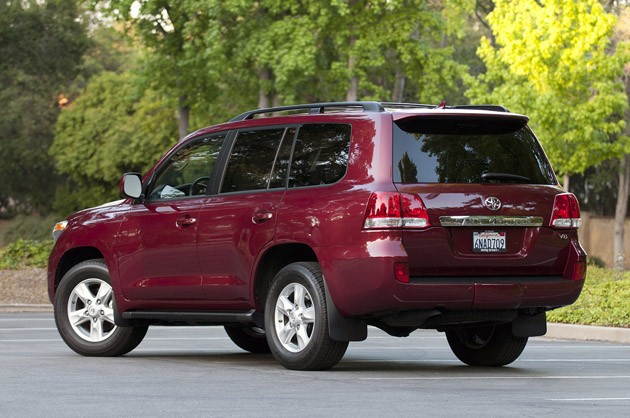
Our biggest regret is that during our week with the Land Cruiser we never come close to exploring its true capabilities. There was no opportunity to crawl over sand dunes in Dubai, navigate the dark jungles of the Amazon or even plunge it into a creek and cover its alloy wheels with muddy water. Our multiple urban Los Angeles outings, with the exception of towing the race car to the high desert, could have been just as easily accomplished with... well, a much less expensive Toyota Highlander. Looking at the automaker's domestic sales volume just last month (the company sold 5,755 Highlanders and just 99 Land Cruisers in May) we aren't alone in our thinking.
So, why choose a Land Cruiser when its little sibling will do nearly as well? Why choose an ox over a mule?
The lowly mule is inexpensive, but it is also far less talented. Farmers who know better, and can afford it, will pay a higher price for the ox as it is a historically-proven toiler commanding a premium for its temperament, capability, ruggedness, reliability and long-term value. Interestingly enough, and not too surprising, those are the same qualities that make the 2011 Toyota Land Cruiser a discerning and justifiable purchase for a couple thousand Americans each year.
2011 Toyota Land Cruiser - Click above for high-res image gallery
An ox is a domesticated bovine whose primary purpose is to pull heavy loads. Tipping the scales at more than a ton, the hefty animals are not considered quick workers, especially when compared to horses, but they're steadfast in their actions and respond well to trained commands. Rarely spooked or unsettled, oxen deliver a long, dependable and rather unassuming service life.
Toyota's Land Cruiser is the ox's four-wheeled equivalent. While the full-size sport utility vehicle is one of the automaker's slowest-selling vehicles on U.S. shores – and one of its most expensive – those who've owned one tend to become very loyal fans. We recently spent a week with the current "200 Series," the latest generation of the venerable 'ute that has been in production since the 1950s. What has given the Land Cruiser such longevity and how does it compare to the Lexus LX570, its nearly identical twin? Most importantly, did we become loyal Land Cruiser devotees in the process?
The Land Cruiser is as legendary as John Wayne. The off-roader traces its roots back to 1951, when Toyota Motor Corporation built itself a rival to the rugged, war-proven U.S. Jeep and British Land Rover. The Japanese automaker called its vehicle the "Jeep BJ." After proving itself by driving up to the sixth-stage of Mount Fuji – no other vehicle had ever accomplished the task – the country's National Police Agency ordered 289 copies. In 1954, Hanji Umehara came up with the famed "Land Cruiser" name.
Early BJ and FJ models were followed by numerous generations of Land Cruisers, which each bore a numerical series name (Model 20, 30 Series, 40 Series, 55 Series, 60 Series, 70 Series, 80 Series, 90 Series, 100 Series and 120 Series, which ended production in 2007). In 2008, Toyota introduced the all-new 200 Series, based on a heavily modified Toyota Tundra chassis. While other countries are offered a bevy of engine options, including turbodiesel configurations, the eight-passenger truck is loaded with features and positioned as a flagship in the U.S. where it's sold as the Land Cruiser and also re-badged as the Lexus LX570.



The current Series 200 debuted to intense scrutiny from loyalists, which was expected. While Toyota fitted it with a more substantial brake system and addressed front suspension issues that had plagued its predecessors, many felt the styling was far too conservative. Nevertheless, the vehicle was as rugged as ever, easily capable of leading the competitive Land Rover Range Rover through the harshest of off-road environments. It's that same durability that continues to make the Land Cruiser the vehicle of choice for NATO and armed forces around the globe. Not to mention the baddies they're battling.
At the heart of the Land Cruiser is a burly 5.7-liter V8 (3UR-FE), which is also shared with the Toyota Tundra, Toyota Sequoia and Lexus LX570. With an all-aluminum construction, the 32-valve powerplant develops 381 horsepower at 5,600 rpm and 401 pound-feet of torque at 3,600 rpm. The standard transmission is a six-speed electronically-controlled automatic transmission sending power to a full-time four-wheel-drive system.

Its mechanicals include a two-speed transfer case with a Torsen limited-slip locking center differential that delivers 60 percent of the power to the rear wheels under normal driving conditions. Modern digital aids include traction control (TRAC), Hill-start Assist Control (HAC) and Vehicle Stability Control (VSC). There's also a multi-speed electronic "Crawl Control" to automatically manage throttle and brake action at crawling speeds during serious off-road excusrions. If the driver wishes, everything but the steering may be managed by the Land Cruiser when traveling off the beaten path.
The video meant to be presented here is no longer available. Sorry for the inconvenience.
The front suspension is a coil spring double-wishbone configuration, with the rear a four-link trailing-arm solid-axle. While the Lexus LX570 boasts Active Height Control (AHC) and Adaptive Variable Suspension (AVS), the slightly less expensive Land Cruiser makes due with standard coil springs. And, where the Lexus wears flashy 20-inch alloys (285/50R20), the Toyota is fitted with standard 18-inch units (285/60R18) with taller sidewalls for improved off-road ride and performance. The brakes on the Land Cruiser are identical to those on the LX570, with both featuring four-piston calipers up front (13.4-inch rotors) and dual-piston calipers in the rear (13.6-inch rotors). Toyota says the anti-lock braking system has been calibrated for use both on- and off-road.
The capabilities of a mechanical ox don't come lightly or cheaply. Toyota lists the curb weight of its Land Cruiser as 5,765 pounds (more than two hundred pounds lighter than the Lexus LX570). Our test model carried a base price of $65,970 (plus $810 for deliver and processing), but was fitted with the Upgrade Package (DVD navigation, backup camera, rear seat entertainment, etc...) bringing the total to $74,210. For comparison, the Infiniti QX56 4WD starts at $61,800 and the Land Rover Range Rover starts at $79,685.




Surprisingly smaller in overall stature than the Toyota Sequoia, the Land Cruiser is a legitimate eight-passenger vehicle that seats five comfortably. There are two bucket seats up front with a conventional three position bench in the second row. The three additional seating positions are stowed, like jump seats in a military C-130 transport aircraft, folded against the side walls of the rear cargo area until the troops need them (yes, they waste precious cargo space in the process). A swift pull drops them into the place. Once secured, don't set hopes too high as the accommodations in the third row are decidedly third class. Legroom is tight and the seating position won't even keep children happy for long. If that doesn't dissuade you, the crawl into the way-back through the second-row tumbled seat will.
Other than the three passengers banished to the back, the five other occupants in the Land Cruiser's cabin will be very happy. Four-zone climate control is standard, with 28 (!) vents ensuring that gentle breezes blow throughout the passenger cabin. For extreme cold, when a traditional coolant-based heater may not be up to the task, the Toyota is also equipped with a standard electrically-heated ceramic element to keep passengers cozy. Other standard features include privacy glass, smart key, heated front seats, auto-dimming mirrors and a 14-speaker JBL premium sound system with in-dash six-disc CD changer. The very short options list includes a rear seat entertainment system, simulated wood/leather steering wheel, cool box, rain-sensing wipers, rear spoiler and second-row seat heaters.
The cabin fit and finish is good, but the materials seem chosen for their durability over luxury. Most of the surfaces seem hard and plastic. Even the fake wood, which Toyota makes no attempt to hide by calling it "wood-grain-style trim," is embarrassingly cheap in appearance and feel. On the plus side, one gets the impression that a wet towel will wipe the dirt and dust off everything without any damage. While nearly identical mechanically, the LX570 and Land Cruiser each have a unique dashboard and center console. We prefer the look of the Toyota, sans the bluish-tint common on late-model Lexus products.
While oxen have a very difficult time balancing on three legs (they are often hung in slings when shoeing), Land Cruisers are as surefooted as mountain goats both on- and off-road. All Land Cruisers sold in our market are fitted with Toyota's Kinetic Dynamic Suspension System (KDSS) as standard equipment. In layman's terms, it means the front and rear sway bars are acted upon by hydraulic cylinders. By varying the pressure exerted on each bar, and through pressure-sensing valves, sway stiffness may be altered while driving. At one end of the scale the system sets itself to firm to significantly reduce the SUV's body roll during on-road cornering. At the other end, the system will disengage itself from the sway bars allowing each wheel to deliver impressively generous travel while off-road. It is innovative engineering that seems to work very well.




The weekend the Land Cruiser was in our garage was also the same weekend we were racing a spec-class Porsche Boxster with the Porsche Owner's Club at Willow Springs. With the Land Cruiser conveniently fitted with a standard Class III tow hitch, we decided to put it to work. Hooking the trailer to the Land Cruiser was simple, thanks to the back-up camera that makes easy work of maneuvering. When the trailer wheel is lifted and the truck bears the tongue weight, the rear of the Land Cruiser drops a couple inches. That wasn't an issue until later, when we noticed our fixed headlights blinding oncoming traffic at night. It was the only time we wished for the LX570's self-leveling air suspension.
The Boxster/trailer package came in at about 5,500 pounds – safely below the Toyota's 8,200-pound towing limit – and the SUV barely broke a sweat. Fourth gear in the six-speed gearbox is a direct drive, while both fifth and sixth gears are overdrive ratios. An electronic control unit estimates road conditions to select the proper gear and in practice does an excellent job, with very little hunting even while towing. In addition, the engine also features a water-cooled oil cooler to help control temperatures while under extreme loads. The Land Cruiser made an excellent tow vehicle with a near-perfect combination of power, stability and passenger comfort (we also really liked the "Cool Box" for keeping our drinks cold).



Unfortunately, while the Land Cruiser reminds us of an ox with regards to its temperament and work ethic, it drinks like a dehydrated camel. The EPA rates the vehicle at 13 mpg city and 18 mpg highway, but our real-world experience says to expect much less if you don't spend a lot of time on the highway. The only upside is that its large 24.6 gallon fuel tank promises a semi-decent range between costly fill-ups.
Nitpicking, our sole gripe with the Land Cruiser has nothing to do with those terrible third-row seats or its thirst for fuel – those are compromises we can live with. Our frustration is found with the simple 80's-era halogen headlamps. Toyota touts the commonplace bulbs as "field serviceable" and cites concern with glare from modern HID systems. We say we've seen brighter LED battery-powered flashlights.
Other than the illumination issue, we found the big Toyota enjoyable and easy to live with. Acceleration is impressive (Motor Trend recorded a 0-60 time of just 6.5 seconds) and the brakes are more than up to the task. The driving position is comfortable and commanding with outward visibility that never bothered us whether navigating city streets, changing lanes on the highway or while parking (the reverse camera helps). Kids found it easy to get both in and out, and they commented on the big door handles, expansive windows, overhead air conditioning vents and generous storage within the cabin. The Land Cruiser is expensive, but we don't think any owners will feel buyer's remorse.

Our biggest regret is that during our week with the Land Cruiser we never come close to exploring its true capabilities. There was no opportunity to crawl over sand dunes in Dubai, navigate the dark jungles of the Amazon or even plunge it into a creek and cover its alloy wheels with muddy water. Our multiple urban Los Angeles outings, with the exception of towing the race car to the high desert, could have been just as easily accomplished with... well, a much less expensive Toyota Highlander. Looking at the automaker's domestic sales volume just last month (the company sold 5,755 Highlanders and just 99 Land Cruisers in May) we aren't alone in our thinking.
So, why choose a Land Cruiser when its little sibling will do nearly as well? Why choose an ox over a mule?
The lowly mule is inexpensive, but it is also far less talented. Farmers who know better, and can afford it, will pay a higher price for the ox as it is a historically-proven toiler commanding a premium for its temperament, capability, ruggedness, reliability and long-term value. Interestingly enough, and not too surprising, those are the same qualities that make the 2011 Toyota Land Cruiser a discerning and justifiable purchase for a couple thousand Americans each year.

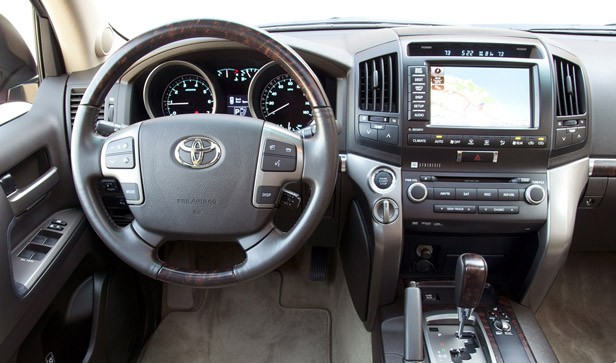
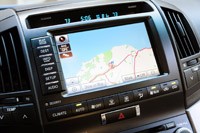
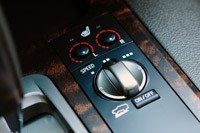
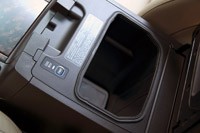









Sign in to post
Please sign in to leave a comment.
Continue